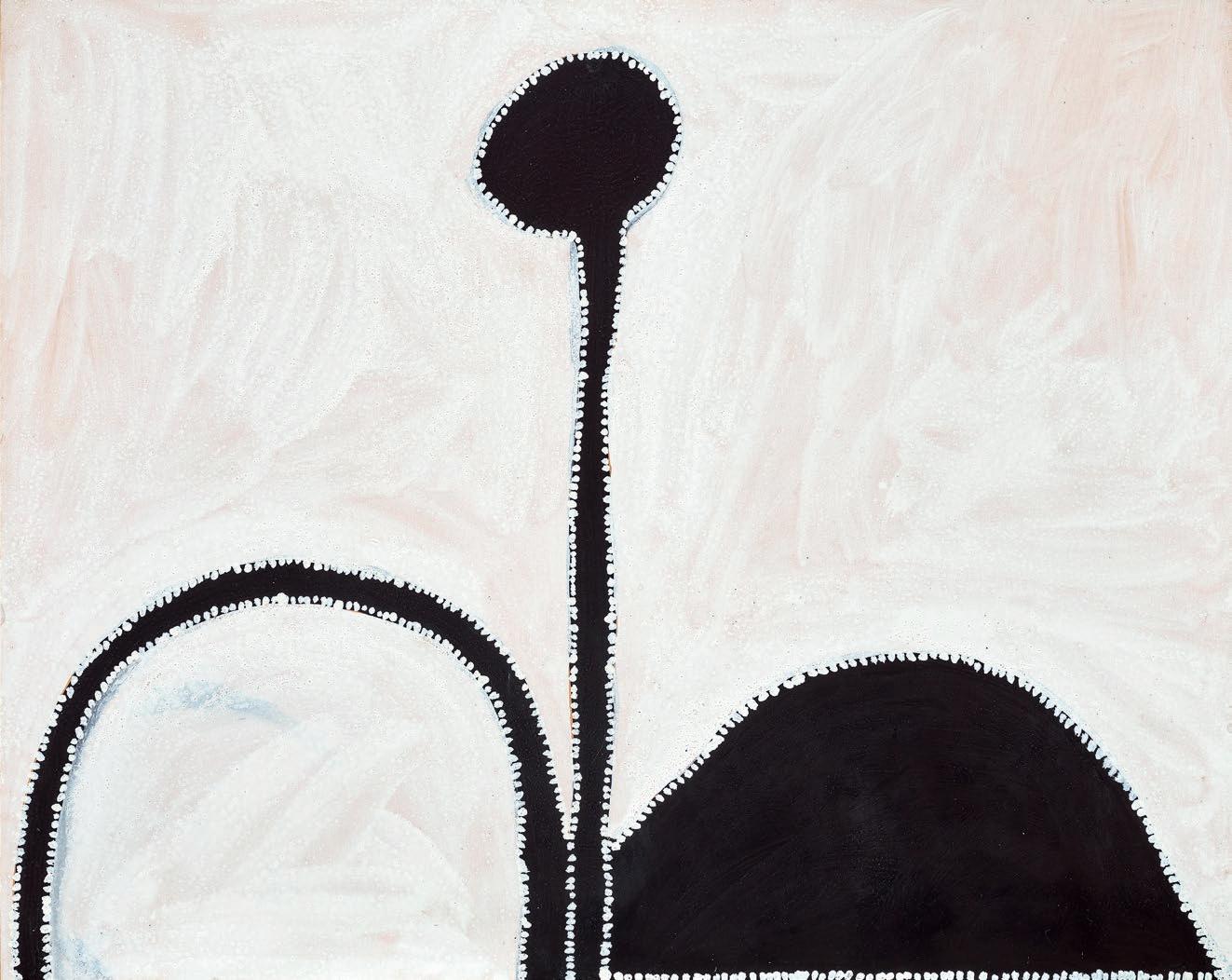
23 minute read
various vendors lots 59 – 79
(c.1922 – 2007) CAMEL GAP, 2004 ochres and pigments with synthetic binder on composition board 80.5 x 100.5 cm signed with initials verso: PB bears inscription verso: Jirrawun Arts cat. PB CB 3-2004-17
ESTIMATE: $45,000 – 65,000
PROVENANCE
Jirrawun Arts, Kununurra, Western Australia The Estate of Paddy Bedford Bonhams, Sydney, 21 November 2011, lot 3B Private collection, Sydney
EXHIBITED
Paddy Bedford: Crossing Frontiers, Museum of Contemporary Aboriginal Art (AAMU), Utrecht, The Netherlands, 8 October 2009 – 11 April 2010
LITERATURE
Storer, R., Paddy Bedford, Museum of Contemporary Art, Sydney, 2006, p. 161 (illus.) Petitjean, G., et al., Paddy Bedford: Crossing Frontiers, Museum of Contemporary Aboriginal Art (AAMU), Utrecht, The Netherlands, and Snoeck Editions, Heule, Belgium, 2009, p. 95 (illus.)
RELATED WORK
Camel Gap, 2004, ochres and pigment on linen, 150.0 × 180.0 cm, in the collection of the Museum of Contemporary Art, Sydney donated through the Australian Government's Cultural Gifts Program by Colin and Elizabeth Laverty, 2012 ‘Paddy Bedford’s paintings articulate a complex dialectic between modern materials and traditional pictorial conventions, contemporary experience, and ancient belief systems’.1
Drawing from two very different sources of knowledge, and painting with a deep sense of history and cultural responsibility, Paddy Bedford mapped the rich history of the east Kimberley using stories from his father’s, mother’s and uncle’s country. Within his canvases, historical events together with the more mundane stories about daily life on cattle stations co-exist with profound and lyrical understanding of the land and its creation stories. Bedford explored the important stories from its past whilst painting the bones of the landscape with the waterholes, stockyards and roads that he traversed throughout his life. Painted in 2001, Camel Gap, documents an evolution in the artist’s painting style, moving beyond the more familiar ochre representations of country produced by earlier East Kimberley artists, and predicting his further innovative changes in palette and technique.
Camel Gap, also known as Gernawarliyan to the local Gija people, is found in the traditional country of the artist’s mother. Located to the south-east of Bedford Downs station and adjacent to Marty’s bore, a few kilometres east of the Springvale – Lansdowne Road, it is a place where in mythological times, the goanna Garndoowoolany camped in the ngarranggarni (Dreaming). Garndoowoolany called out to Marranyi, the dingo, whom he saw at the top of the hill. It was here that Marranyi got stuck and became part of the rock. Its English name refers both to the shape of the hill and, also to the Afghan cameleers who, in the early twentieth century, travelled past this place on their journey south from the port at Wyndham to remote Kimberley communities and further afield for trade.
1 Michael Dolk cited in Storer, R., ‘Paddy Bedford’ in Michael, L., Paddy Bedford, Museum of
Contemporary Art, Sydney 2006, p. 11
CRISPIN GUTTERIDGE
(c.1936 – 2002) LIMMEN BIGHT COUNTRY, c.1990 synthetic polymer paint on canvas 172.5 x 188.0 cm bears inscription verso: artist’s name and Alcaston Gallery cat. AK853
ESTIMATE: $50,000 – $70,000
PROVENANCE
Alcaston Gallery, Melbourne Private collection, Melbourne, acquired from the above in March 1991
This work is accompanied by a certificate of authenticity from Alcaston Gallery.
‘‘My mother’s country is in my mind.’1
Distinguished by their daring palette, dynamic energy and strongly flattened forms, Riley’s bold, brilliantly coloured depictions celebrating the landscape and mythology of his mother’s country are admired among the finest in contemporary Indigenous art. Emerging at a time when barks were the familiar output for his Arnhem Land country and Papunya Tula paintings were considered the norm, his striking interpretations not only challenged, but irrevocably changed, preconceived notions of Indigenous art – thus earning him the moniker ‘the boss of colour’ by artist David Larwill. Notably influential upon such idiom was Riley’s chance encounter during his adolescence with celebrated watercolourist Albert Namatjira, whose non-traditional aesthetic and concept of ‘colour country’ left an indelible impression upon the young artist. Encouraged by ‘…the idea that the colours of the land as seen in his imagination could be captured in art with munanga (white fella) paints’,2 it was not, however, until three decades later that Riley would have the opportunity to fully explore his talent when the Northern Territory Open College of TAFE established a printmaking workshop in the Ngukurr Aboriginal Community (formerly known as the Roper River Mission). Notwithstanding his mature age of 50, Riley rapidly developed his own highly sophisticated style and distinct iconography and, after initially exhibiting with the other Ngukurr-based painters, soon established an independent career at Alcaston Gallery. Enjoying tremendous success both locally and abroad over the following sixteen years before his untimely death in 2002, Riley received a plethora of awards including the inaugural National Heritage Commission Aboriginal and Torres Strait Islander Art Award in 1993 and an Australia Council Fellowship in 1997 – 98, and in 1997, was the first living indigenous artist to be honoured with a retrospective at the National Gallery of Victoria, Melbourne.
Capturing the saltwater area extending from the coast of the Gulf of Carpentaria along the Limmen Bight River to the weather-worn rocky outcrops known as the ‘Four Arches’, Limmen Bight Country, c.1990 offers a stunning example of Riley’s heroic landscapes. Pivotal to the composition is Garimala, the mythological Taipan who, according to the ancestral dreaming, created the Four Arches – an area regarded as ‘… the centre of the earth, where all things start and finish’3 – and lives in the waterhole nearby. Here the mythological serpent is transformed into Bulukbun – the angry, fire-breathing ‘serpent-dragon’ – and envisaged in duplicate, rising above the Four Arches depicted in ochre with vegetation atop, while the cobalt blue sky beyond is framed by yellow chevrons, a motif derived from Riley’s Yidditja ritual body paint designs.
A vibrant celebration of the joy of belonging to the saltwater country of the Mara people, indeed the work embodies Riley’s powerful vision of his mother’s country as a mythic space – a mindscape whose kaleidoscope of dazzling colours and icons continually evoke wonder and mystery in the viewer with each new encounter.
1. Riley cited in Ryan, J.,Ginger Riley, National Gallery of Victoria, Melbourne, 1997, p. 15 2. Riley cited ibid. 3. Riley, ibid., p. 29
VERONICA ANGELATOS
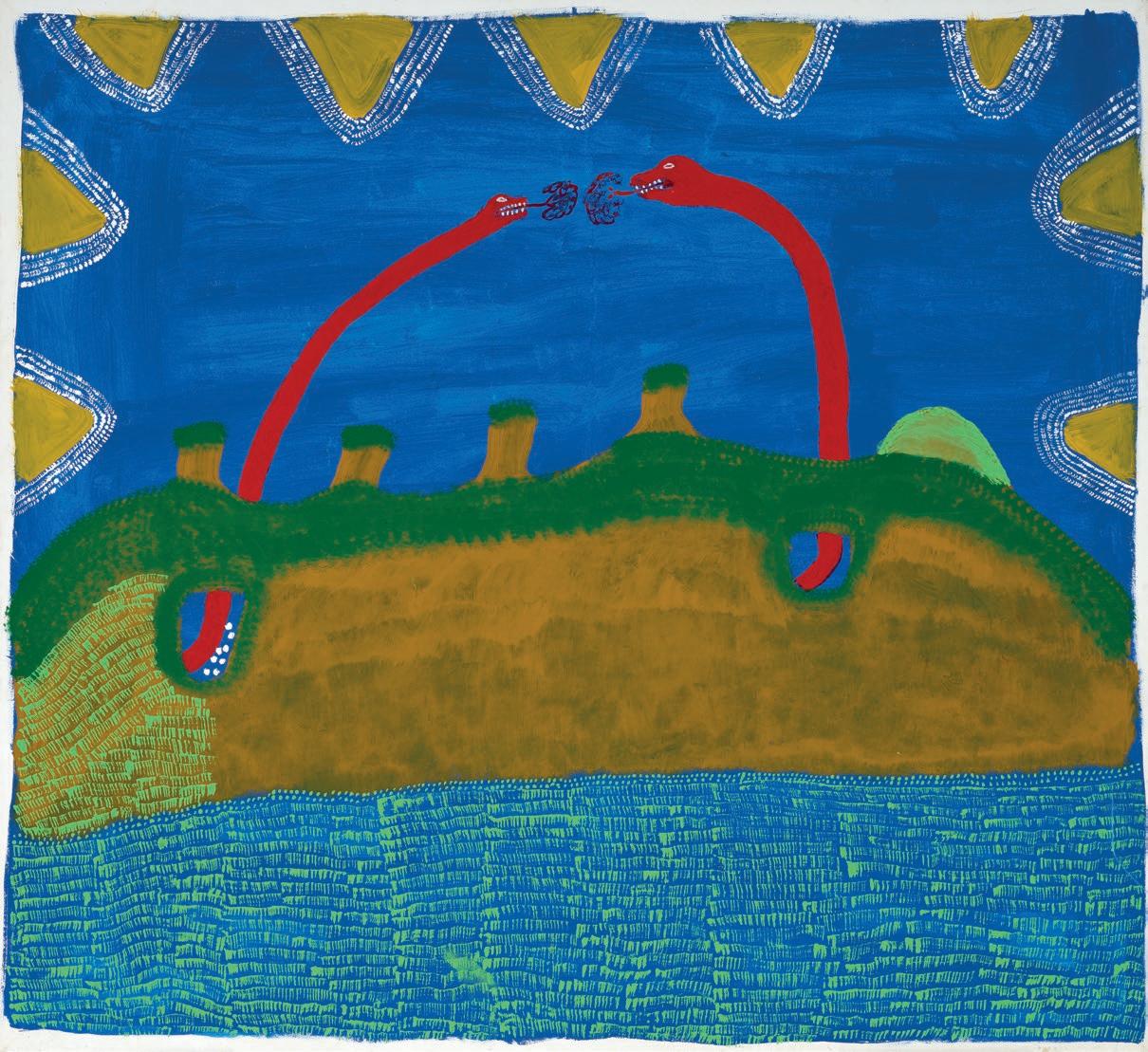
(1908 – 1987) UNTITLED, c.1981 oil on canvas 208.0 x 250.0 cm bears inscription verso: COVENTRY
ESTIMATE: $40,000 – 60,000
PROVENANCE
Estate of the artist, Melbourne, until 2000 Eastgate & Holst, Melbourne Private collection, Perth, acquired from the above in 2005
EXHIBITED
Director’s Choice, Eastgate & Holst, Melbourne, September 2005 Abstraction 21, Charles Nodrum Gallery, Melbourne, 16 October – 20 November 2021, cat. 7
LITERATURE
Makin, J., ‘Stars blossom in spring’, Herard Sun, 19 September 2005, p. 96 (illus.)
‘Whether the forms are the circle and square or the cruciform image… the cycle of Kemp’s experience returns again and again to the same states of being. Energy and rhythm are everywhere apparent and their passage into structural form provides one of the enduring formal and iconographic themes of his art.’1
Grounded in geometry and mediated by gesture, Roger Kemp’s bold abstract paintings are unique within late twentieth century Australian art, revealing both the singular vision and expressive hand of their maker. Kemp’s purpose also set him apart. There is no narrative in his work, no obvious figuration or representational aim. He sought instead, to express a deeper meaning through his art, a personal perspective ‘that alluded to the timeless and universal, a means to articulate his experience of a higher truth.’2
Dedicating himself to painting full-time from 1966, the 1970s was a critical decade in Kemp’s career, which saw his practice widely acknowledged and celebrated. His work was included in the inaugural Sydney Biennale in 1973, he was awarded an OBE for services to Australian art in 1977, and in 1978, a group of works was acquired for the developing national collection. By this time, Kemp had also established a strong relationship with Marianne Baillieu, who ran Realities Gallery in Melbourne, and she energetically championed his work, presenting it in successful commercial exhibitions and placing it in important private and public collections. Slowed down by a stroke in 1980, Kemp had to relearn the use and control of his body, but his motivation and creative drive remained strong. Initially working on a small scale, he was soon producing vast mural-sized paintings which had become such a signature element of his oeuvre during the previous decade. Further accolades and recognition were to follow, including a commission (completed in 1984) to produce a suite of large-scale tapestries for the Great Hall at the National Gallery of Victoria. Hanging against towering bluestone walls beneath Leonard French’s stainedglass ceiling, the Kemp tapestries were well known to visitors to the gallery for decades to come.
Created around 1981, this untitled painting exemplifies the expressive dynamism and graphic power of Kemp’s work. His familiar palette of dusty blues and purples is combined here with vibrant shades of red, orange and pink, which are arranged, mosaic-like, into a series of geometric shapes. A red cruciform in the lower left of the canvas and four floating circles dominate the composition, but jostling against smaller, less structured blocks of colour and areas of expressive, gestural painting in the background, they are held in a finely balanced equilibrium. Black and white painted lines define the forms and animate the image, emphasising the feeling of movement across the painting’s surface which vibrates with a palpable sense of energy. The scale on which Kemp worked demanded that painting was a very physical act and, beginning with a preparatory sketch to outline the composition, he then worked freely, as this painting shows, ‘without traces of mannerism, artifice or guile… There was no apparent struggle, no erasures or revisions.’3
1. McCaughey, P., Roger Kemp: Cycles and Directions 1935-1975, Monash University,
Melbourne, 1978, n.p. 2. Heathcote, C., A Quiet Revolution: The Rise of Australian Art 1946 – 1968, Text Publishing,
Melbourne, 1995, p. 7 3. See Heathcote, C., The Art of Roger Kemp, Macmillan, Melbourne, 2007, p. 140
KIRSTY GRANT

(1927 – 2022) CITYSCAPE / DEEP DREAM, 1994 oil on canvas 110.0 x 120.0 cm signed, dated and inscribed with title verso: Ken Whisson / Perugia 22/1/94 / + 16/2/94/ + 18/3/94 / Title: “Cityscape / Deep Dream”
ESTIMATE: $25,000 – 35,000
PROVENANCE
Watters Gallery, Sydney (labels attached verso) Private collection, Sydney, acquired from the above in 1997
EXHIBITED
Ken Whisson paintings & drawings, Watters Gallery, Sydney, 22 October – 8 November 1997, cat. 7 (illus. in exhibition catalogue)
By the time Ken Whisson came to paint Cityscape / Deep Dream, 1994, he had been living permanently in Italy for 17 years and settled into the rhythm of painting and sending the paintings back to Australia for annual solo exhibitions. During these years, the artist was at last comfortable and at ease with commercial and critical success. He was also able to travel abroad more freely and made the most of his annual trips to Australia. He would usually stay a couple of months and visit relatives and friends in most major cities, as well as making trips into the country. A look over the dates of many Whisson works reveals the European winter was a very productive time and it is no coincidence that these periods of high productivity followed his trips abroad. His memories and recollections from his time away would be perfect material for an artist who draws deeply on what he has seen, and how he now sees it.
The present work was painted between January and March 1994 following Whisson’s return to Italy. The upper area of the work appears to represent the vertical forms of a city, with details such as buildings, trees and chimneys represented by drapes of low-key colour. Two large clouds threaten to obliterate the sunrise. An abstracted subterranean world beneath presents an alternate perspective which appears open, airy and accessible. We are drawn into the interior of the city and feel the human scale of doors windows, walls and space. So, on one level we have the real experience of the entering the city as we fit into its domestic scale, and on another we have the imagined reality of the city, looming large, towering above.
There is a familiarity about Whisson’s landscapes for they are constructed of essential matter-of-fact fragments of memory that most of us share; trees are green, roads are grey and so are clouds. Cows have four legs and a tail, so do dogs – but cows are bigger. Birds have wings and fly up and around, they are hard to see because they move fast and blur when they fly. Of course, in reality the details of these examples are nuanced; no two greens or two trees or two cows are ever exactly the same, but their essential values in terms of form, patterns, mass and colour, which trigger memories are generally shared ones. In Whisson’s landscapes, everyday features become stylised versions of themselves. It is his ability to take these and add weight, mass and shape that creates the common denominator through which we view these paintings; it is what causes them to appear familiar and evocative. This is the level on which Whisson works; he is exploring the mechanics of memory, which is something we all share. An image of a particular tree for example can trigger memories, as far back as childhood, in an instant. A particular shade of colour can evoke an avalanche of recollection from a holiday, a place or an event. Once the door is open, memory floods the mind to create fragmented narratives, which Whisson presents as layers of colour, form and line. His completed paintings are a form of mental cubism.
Over a lifetime, Whisson quietly cemented his place in the canon of Australian painting. And until his sudden death at 94 in February this year, was painting daily with a fierce enthusiasm. The consistency of his output over many decades is unmatched and his often-polarising paintings are simply unique in Australian art. His 2012 retrospective exhibition held at Sydney’s Museum of Contemporary Art and the Heide Museum of Modern Art in Victoria, was a brilliant and uplifting testimony to his importance.
HENRY MULHOLLAND
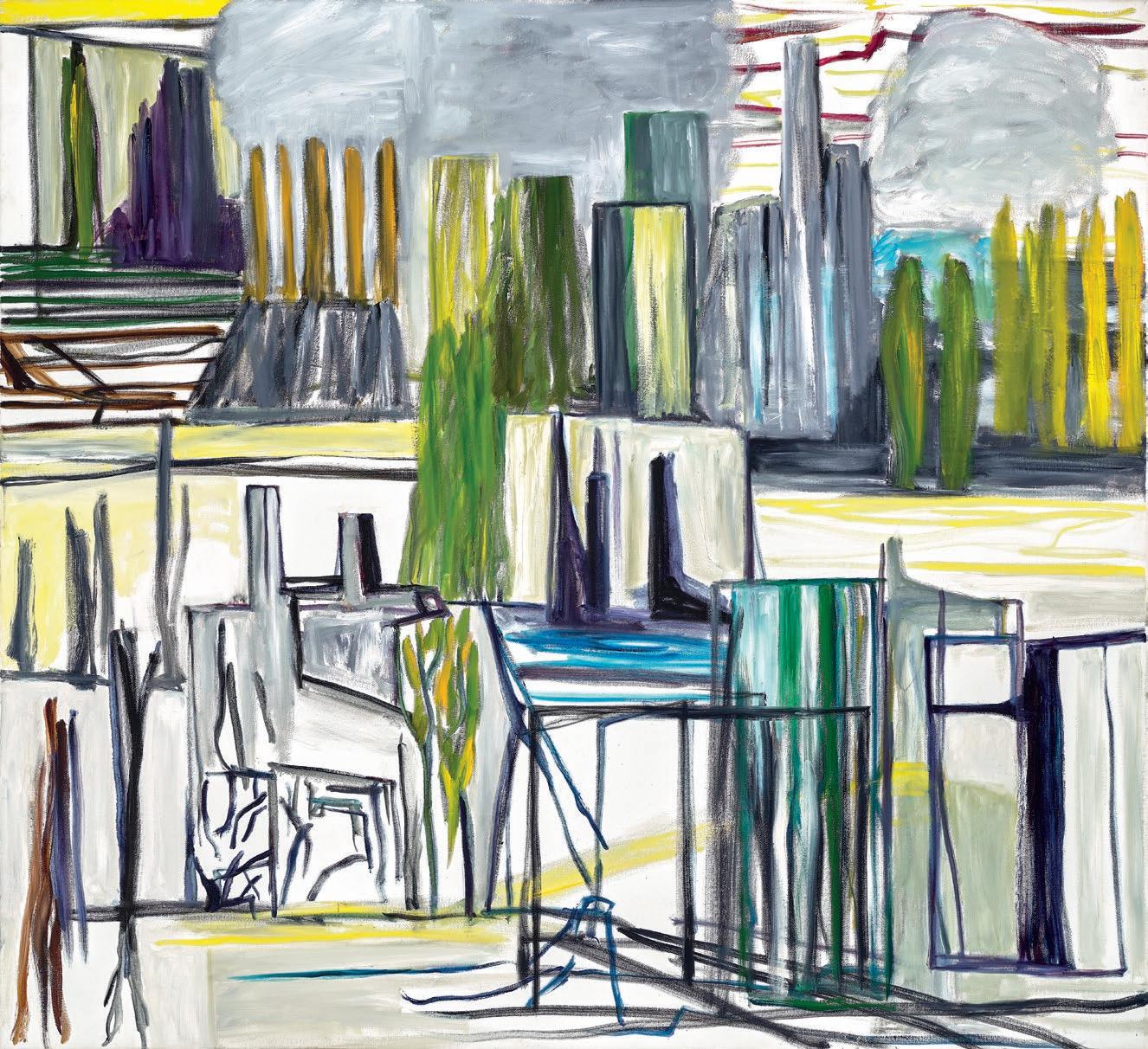

ROSALIE GASCOIGNE
(1917 – 1999) COW ANTICS, 1976 printed cardboard (cut–out and reassembled Norco butter logos) on weathered wood panel 35.0 x 50.5 cm signed with initials and dated verso: R.G. ’76
ESTIMATE: $20,000 – 30,000
PROVENANCE
Gallery A, Sydney Private collection, Sydney, acquired from the above in 1976 Deutscher~Menzies, Melbourne, 28 August 2002, lot 145 (as ‘Norco Cows’) Private collection, Canberra
63
EXHIBITED
Rosalie Gascoigne – Assemblage, Gallery A, Sydney, 11 September – 2 October 1976, cat. 41 (as ‘Cowantics’ [sic.])
LITERATURE
Macdonald, V., Rosalie Gascoigne, Regaro Pty Ltd, Sydney, 1998, p. 106 Gascoigne, M., Rosalie Gascoigne. A Catalogue Raisonné, ANU Press, Canberra, 2019, cat. 105, pp. 169 (illus.), 317, 414
RELATED WORK
Norco Cows, 1976, printed cardboard (cut–out and reassembled Norco butter logos) on weathered wood panel, 44.0 x 73.0 cm, in the collection of the National Gallery of Australia, Canberra
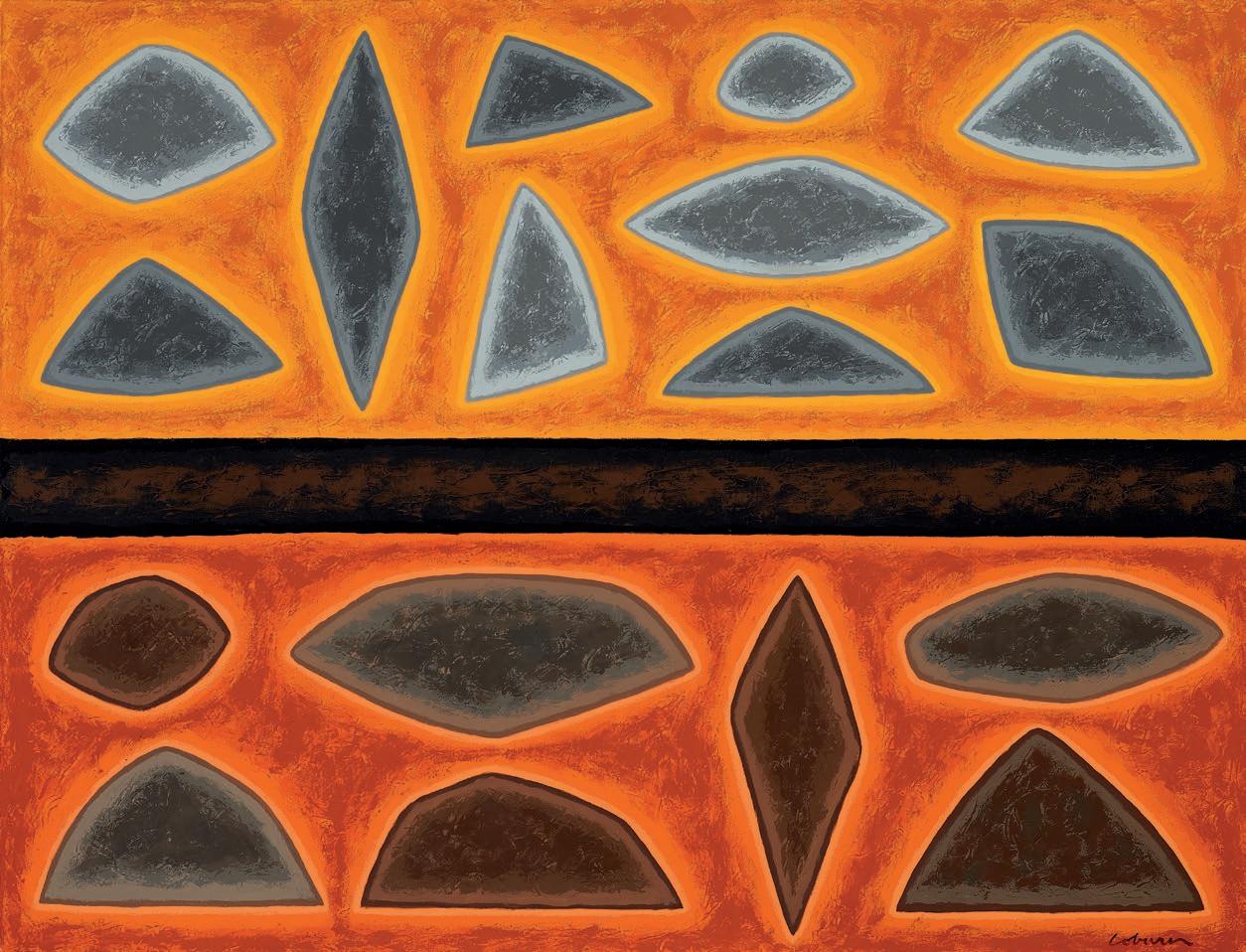
JOHN COBURN
(1925 – 2006) ANNITOWA LANDSCAPE, 1999 oil on canvas 100.0 x 130.0 cm signed lower right: Coburn signed, dated and inscribed with title verso: JOHN COBURN / ANNITOWA LANDSCAPE / 1999
ESTIMATE: $25,000 – 35,000
64
PROVENANCE
Private collection, Melbourne Shapiro Auctioneers, Sydney, 5 May 2017, lot 24 Private collection, Queensland
RELATED WORK
Annitowa Landscape, 1999, lithograph, 42.0 x 63.5 cm, edition of 25, in the collection of the Tasmanian Museum and Art Gallery, Hobart

CONSTANCE STOKES
(1906 – 1991) WOMAN IN A GARDEN, c.1981 oil on composition board 53.5 x 45.0 cm signed lower right: Constance Stokes
ESTIMATE: $10,000 – 15,000
PROVENANCE
Estate of the artist, Melbourne Lauraine Diggins Fine Art, Melbourne Private collection, Melbourne, acquired from the above in 2021
65
EXHIBITED
Constance Stokes Retrospective Exhibition, Swan Hill Regional Art Gallery, Victoria, 1985, cat. 12 (labels attached verso) Constance Stokes, Eastgate Gallery, Melbourne, 30 May – 4 July 1990, cat. 23 Constance Stokes 1906 – 1991, National Gallery of Victoria, Melbourne, 3 March – 19 May 1993, cat. 16 (label attached verso) Constance Stokes 1906 – 1991, Lauraine Diggins Fine Art, Melbourne, 30 November 2021 – 18 March 2022 (illus. in exhibition catalogue, p. 6)
LITERATURE
Burke, J., Constance Stokes: Retrospective Exhibition, Swan Hill Regional Art Gallery, Victoria, 1985, p. 22 (illus.) D’Albrera, L. W., Constance Stokes: Art and Life, Hill House, Melbourne, 2015, pp. 156, 159 (illus.)

DONALD FRIEND
(1915 – 1989) THE JETTY gouache, watercolour, ink and gold leaf on paper on board 47.5 x 61.5 cm signed and inscribed with title lower right: The Jetty. / Donald Friend bears inscription verso: 2
ESTIMATE: $18,000 – 24,000
66
PROVENANCE
Holdsworth Gallery, Sydney Private collection, Sydney
LITERATURE
d’Alpuget, B., Monkeys in the Dark, Aurora Press, Sydney, 1980 (illus., front cover)

JOHN BRACK
(1920 – 1999) STUDY FOR NUDE WITH NIGHTGOWN, 1957 pencil on buff paper 48.5 x 33.0 cm signed and dated lower right: John Brack / 57
67
ESTIMATE: $20,000 – 30,000
PROVENANCE
Brian and Marjorie Johnstone, Brisbane Marjorie Johnstone, Brisbane, 1992 Private collection, Brisbane, a bequest from the above in 1994
EXHIBITED
Exhibition by John Brack: Paintings and Drawings of the Nude, Australian Galleries, Melbourne, 12 – 29 November 1957, cat. 19 John Brack, Johnstone Gallery, Brisbane, 26 April – 13 May 1960
LITERATURE
Grishin, S., The Art of John Brack, Oxford University Press, Melbourne, 1990, vol. 2, cat. p73, pp. 49, 202 (illus., as ‘p67’)
RELATED WORK
Nude with Nightgown, 1957, oil on canvas, 90.5 x 40.5 cm, private collection, sold Deutscher and Hackett, Sydney, 28 August 2018, lot 5

ROBERT DICKERSON
(1924 – 2015) REDFERN BOY, c.1958 oil on composition board 91.5 x 60.5 cm signed lower left: DICKERSON bears inscription verso: RRBNN
ESTIMATE: $25,000 – 35,000
68
PROVENANCE
Philip Bacon Galleries, Brisbane Private collection, Brisbane, acquired from the above in 1995
EXHIBITED
The Private Collection in Brisbane, Brisbane City Hall Art Gallery and Museum, Brisbane, 1 – 30 June 1990 (label attached verso) 40 Years – 40 Paintings, Philip Bacon Galleries 40th Anniversary, Philip Bacon Galleries, Brisbane, 18 February – 15 March 2014, cat. 22 (label attached verso)
JOHN BRACK
(1920 – 1999) UNTITLED SKETCH (NURSERY), 1962 watercolour and ink on paper 47.0 x 17.5 cm signed and dated lower right: John Brack 62
ESTIMATE: $8,000 – 12,000
69
PROVENANCE
Private collection Lawson~Menzies, Sydney, 15 April 2003, lot 124 Private collection, Canberra
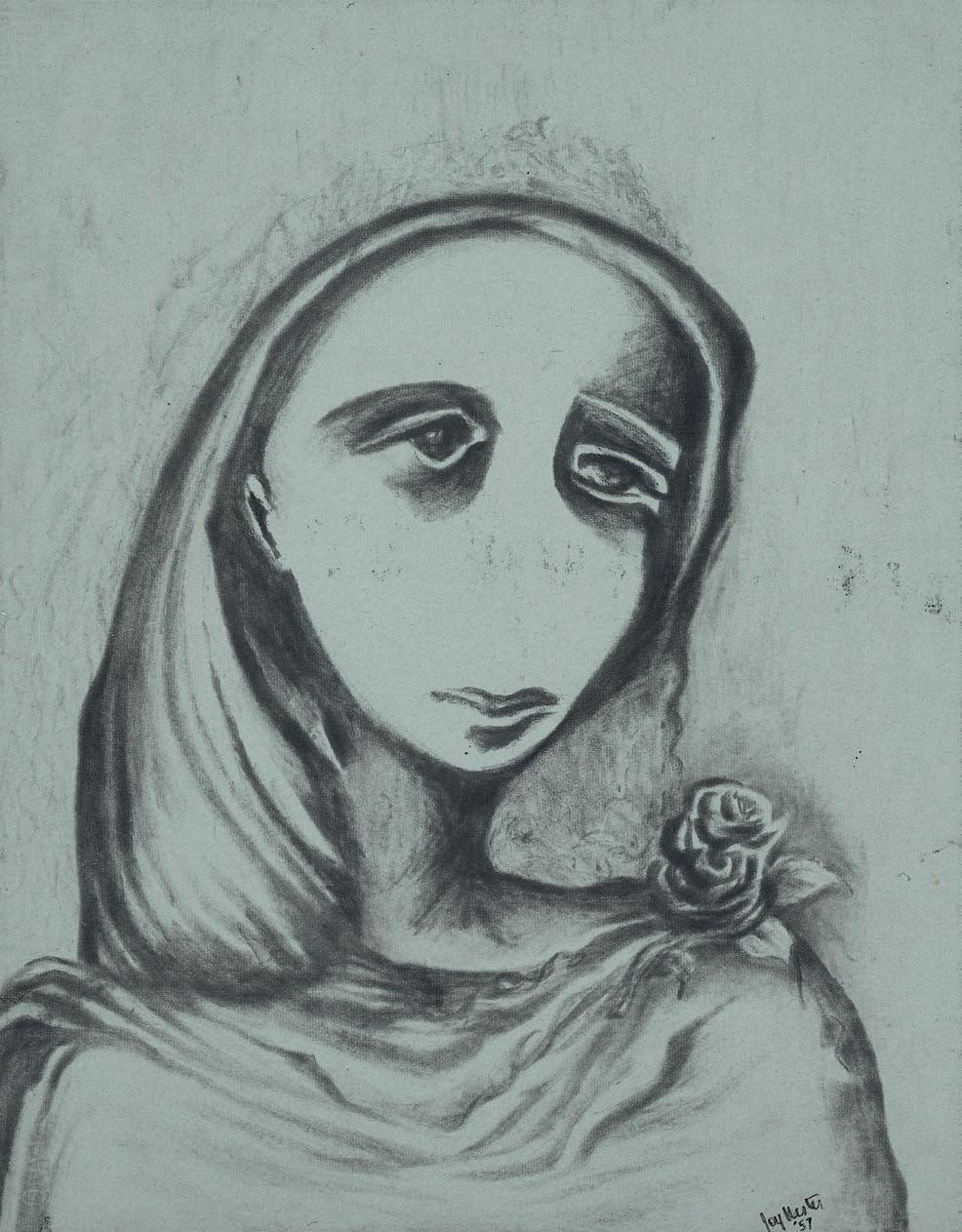
JOY HESTER
(1920 – 1960) WOMAN AND ROSE, 1957 charcoal on paper on cardboard 62.0 x 48.0 cm signed and dated lower right: Joy Hester / ‘57
ESTIMATE: $25,000 – 35,000
70
PROVENANCE
Lauraine Diggins, Melbourne Sotheby’s, Melbourne, 26 November 1990, lot 5 Private collection Private collection, Canberra, acquired in 2002
EXHIBITED
Moderns Exhibition, Lauraine Diggins, Melbourne, 20 June – 8 July 1983, cat. 36 (as ‘Portrait with Rose’, illus. in exhibition catalogue)
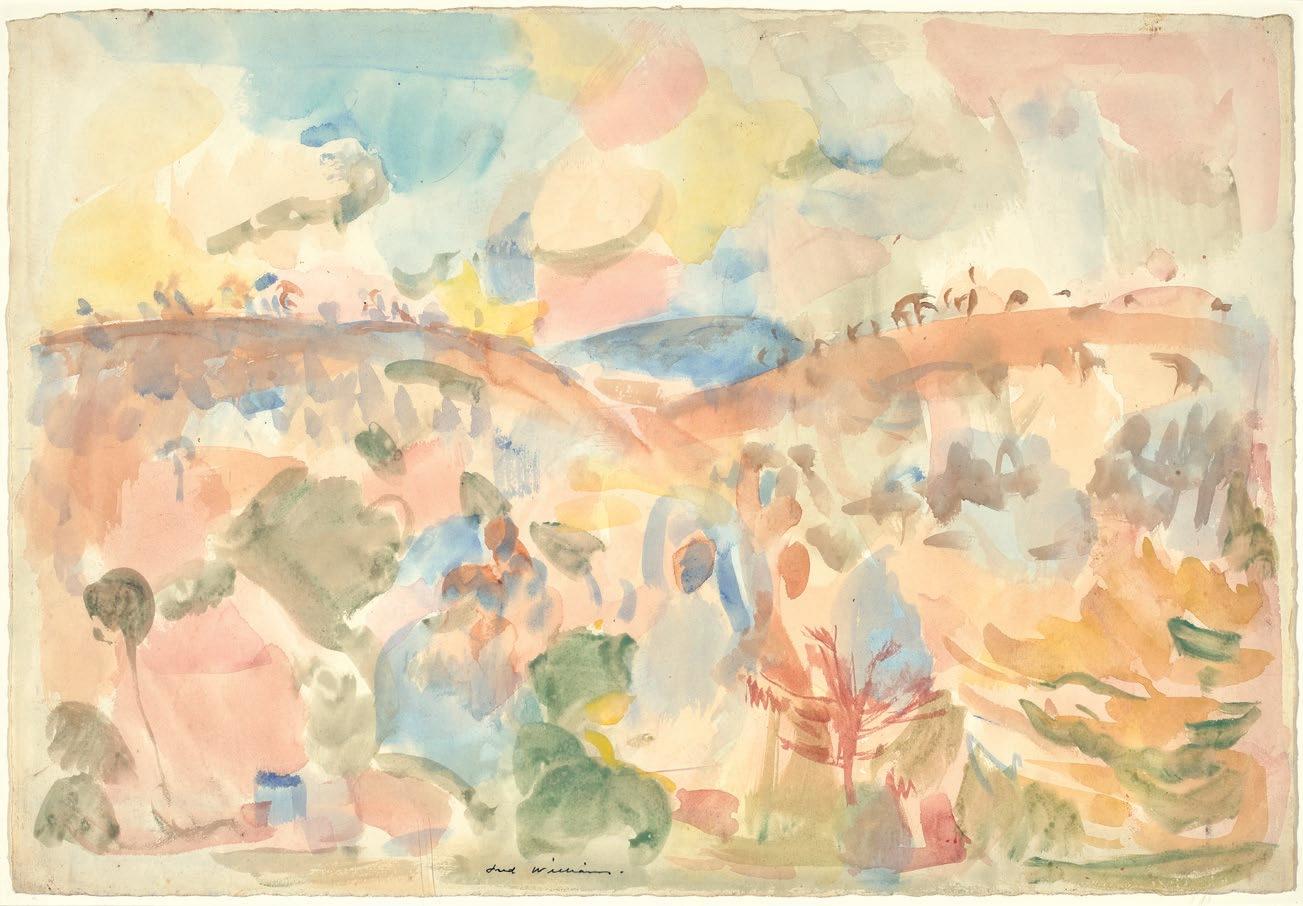
FRED WILLIAMS
(1927 – 1982) OLINDA HILL FROM FOSTER’S GARDEN, SUMMER, 1961 watercolour on paper 39.5 x 57.0 cm (sheet) signed lower centre: Fred Williams.
ESTIMATE: $10,000 – 15,000
71
PROVENANCE
Dr Harold Hattam, Melbourne Thence by descent Private collection Niagara Galleries, Melbourne The Reg Grundy AC OBE and Joy Chambers–Grundy Collection, acquired from the above in 1993 (stamp and label attached verso)
EXHIBITED
Possibly: Fred Williams, Australian Galleries, Melbourne, 20 June 1961

FRED WILLIAMS
(1927 – 1982) MITTAGONG, 1957 gouache on paper 27.5 x 38.0 cm (sheet) signed lower left: Fred Williams bears inscription on typed label verso: ‘MITTAGONG 1957’ / Lyn Williams 1993
ESTIMATE: $25,000 – 35,000
72
PROVENANCE
The Reg Grundy AC OBE and Joy Chambers–Grundy Collection

BRETT WHITELEY
(1939 – 1992) THE CAT IN THE SUNLIGHT, 1980 offset lithograph 81.5 x 83.5 cm (image) 116.0 x 91.0 cm (sheet) edition: 9th Artist’s Proof aside from an edition of 9 signed lower right: brett whiteley numbered and inscribed with title lower left: A/P ‘9’ the cat in the sunlight
ESTIMATE: $25,000 – 35,000
PROVENANCE
Beth Patrick, London, a gift from the artist Private collection, London, a gift from the above in 2005
73
EXHIBITED
Probably: Brett Whiteley, Philip Bacon Galleries, Brisbane, 1981, cat. 8 (another example) The Entire Collection of the Graphics of Brett Whiteley: 1961 – 1981, Australian Galleries, Melbourne, 1981, cat. 56 (another example, as ‘The Cat’)
LITERATURE
Mandy, R., Brett Whiteley: The Complete Graphics, 1961 – 1982, Art Gallery of Western Australia, Perth, 1983, cat. 59, p. 42 (illus. another example) Brett Whiteley: The Graphics 1961 – 1992, Deutscher Fine Art, Melbourne, 1995, cat. 60, p. 67 (illus. another example) Sutherland, K., Brett Whiteley: Catalogue Raisonné, Schwartz Publishing, Melbourne, 2020, vol. 5, p. 121 (illus.), cat. 105P (illus., another example), vol. 7, p. 829

CRESSIDA CAMPBELL
born 1960 BONDI, 1984 woodblock print on paper 34.0 x 89.0 cm edition: 2/4 signed, dated and inscribed with title below image: 2/4 BONDI / Cressida Campbell ’84
ESTIMATE: $18,000 – 24,000
PROVENANCE
Private collection, Canberra, acquired directly from the artist c.1984
74
EXHIBITED
Cressida Campbell: Woodblocks, Woodblock Prints and Paintings, Mori Gallery, Sydney, 12 – 30 March 1985, cat. 24
LITERATURE
Dutton, G., Sun, Sea, Surf and Sand – The Myth of The Beach, Oxford University Press, Melbourne, 1985, pp. 74 (illus., another example), 153 Baker, C., ‘ Bondi - taking hedonism to heart’, The Sydney Review, Sydney, no. 3, August 1988 (illus. another example) Crayford, P., (ed.), The Woodblock Painting of Cressida Campbell, Public Pictures Pty Ltd, Sydney, 2008, cat. P8502, p. 341 (dated 1985)
(1790 – 1868) SKETCHBOOK OF VIEWS IN ITALY, c.1849 bound sketchbook with 39 sketches pencil, pen, ink and wash on paper 12.0 x 19.0 cm (sheet, each) 13.5 x 19.5 cm (book) 34 sketches are numbered and inscribed with title
ESTIMATE: $8,000 – 12,000
PROVENANCE
Private collection, Tasmania, acquired c.1850s Thence by descent Private collection, Tasmania
EXHIBITED
On short term loan to Queen Victoria Museum Launceston, Tasmania, for the purposes of research, 1977 On short term loan to the Australian National Gallery, Canberra, for the purposes of research, 1981 – 82 On short term loan to the Tasmanian Museum and Art Gallery, Tasmania, for the purposes of research, 2000
RELATED WORK
John Glover, (Sketchbook no. 87: Italy), 1818, pencil, pen, ink and wash, 18.1 x 11.8 cm, in the collection of the Tasmanian Museum and Art Gallery, Hobart, illus. in Hansen, D., John Glover and the Colonial Picturesque, Tasmanian Museum and Art Gallery, Hobart, 2003, p. 253
We are grateful to Jane Stewart, Principal Curator, Art for the Tasmanian Museum and Gallery, for her assistance with this catalogue essay.
When the eminent landscape artist John Glover emigrated from England to Van Diemen’s Land, he was accompanied by his wife and eldest son, John Richardson Glover.1 He was sixty-four; John Richardson forty-one. Arriving in Hobart Town in April 1831, they were reunited with his three other sons, who had begun farming on palawa land two years earlier. In 1832 John was granted land by the Nile River in northern Tasmania where they built their house Patterdale. Here he re-established his painting practice, ably supported by John Richardson as studio assistant and farmer. As we know well, John became Tasmania’s most renowned colonial landscape artist. An art teacher in England, John Richardson’s own artistic output in Van Diemen’s Land was limited, and he is best known now for pen and wash drawings recording local buildings and letters describing of their life and activities, significant documents about colonial Tasmanian settlement.
This small sketchbook draws upon the talents and activities of both artists. It is one of the extant examples showing John Richardson’s close artistic relationship with his father, and the vital role that sketching, copying and re-using earlier visual records played before the development of photography. The book contains thirty-nine (previously forty-four) small monochromatic landscapes – the features outlined in pen and ink and enhanced with even tonal washes, which evoke the atmosphere and luminosity of the Italian vistas depicted. A hand-written index, titled Views in Italy, provides locations for the topographical vistas: St Peter’s in Rome, Lake Nemi, the Taro River, Suza and so on.2
Yet John Richardson is not known to have visited Italy. Instead, the numbers at the lower left of each drawing correspond with sketches in one of the 104 sketchbooks John had brought with him to Van Diemen’s Land. John is known to have been an inveterate sketcher and traveller, often fitting multiple sketches per page. His pupil Edward Price wrote: ‘His knowledge was almost entirely derived from the Study of Nature and not from Works of Art. His numerous Sketchbooks are full of Indian Ink drawings made at all hours… Nothing escaped his observation and he never lost an opportunity of noting down anything that was worth remembering.’3 During 1818 John had travelled to Italy, seeing in the flesh picturesque views and edifices that he would have previously only studied in engravings and other tourists’ art. His only surviving Italian sketchbook, Sketchbook 87, is held by the Tasmanian Museum and Art Gallery, Hobart and records some of the evocative landscapes, churches and Roman ruins that he had seen. It is well known that John called upon his sketchbooks throughout his life: in 1835 at Patterdale, for example, he painted My last view of Italy, looking from the Alps over Suza (Art Gallery of New South Wales).
Upon John’s death in 1849, his sketchbooks were distributed between his three surviving sons. Sketchbook 87 was given to John Richardson, and he selected forty-four views to copy for his, or another’s, further use, possibly before sale.4 A Whatman watermark, dated 1849, shows that the sketchbook was made no earlier than the year of John’s death.
1. Contemporary statements suggest that debts accrued by John Richardson influenced their move. 2. Sketches numbered 5 – 8 and 12 are now missing from the book. 3. Edward Price, quoted in David Hansen (ed.), John Glover and the Colonial Picturesque,
Tasmanian Museum and Art Gallery, Hobart, 2003, p. 44 4. Hansen, ibid., p. 264
ALISA BUNBURY

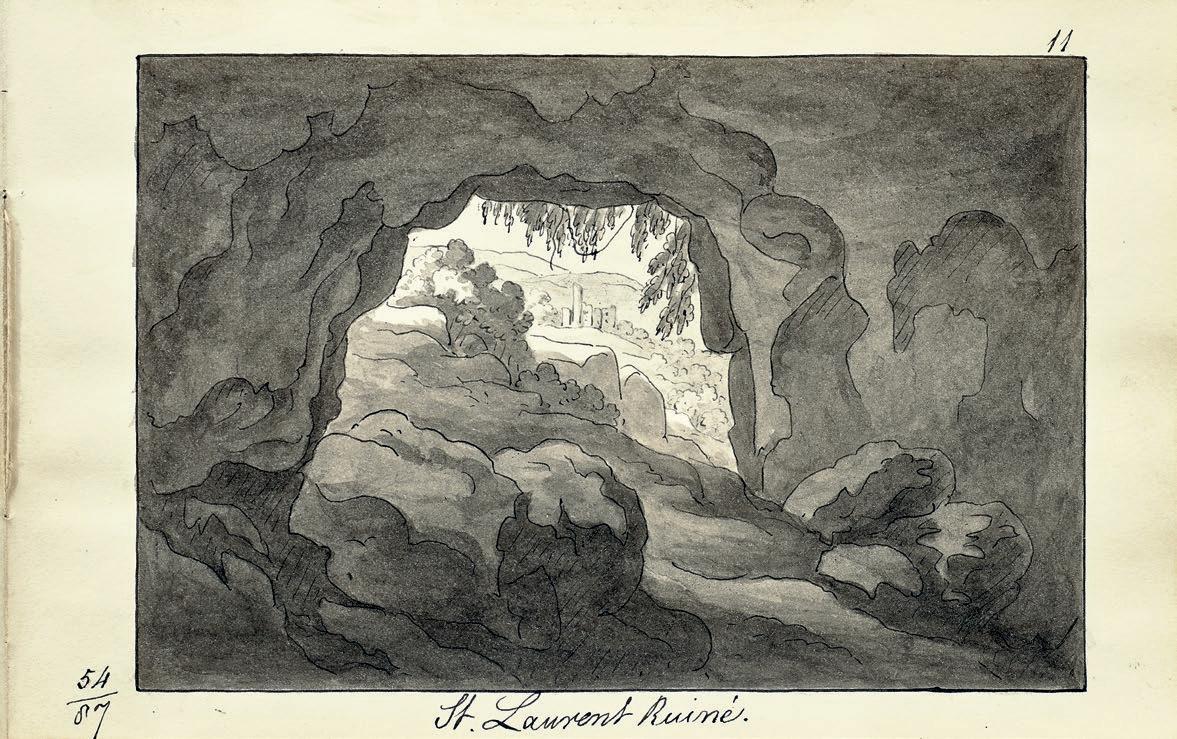
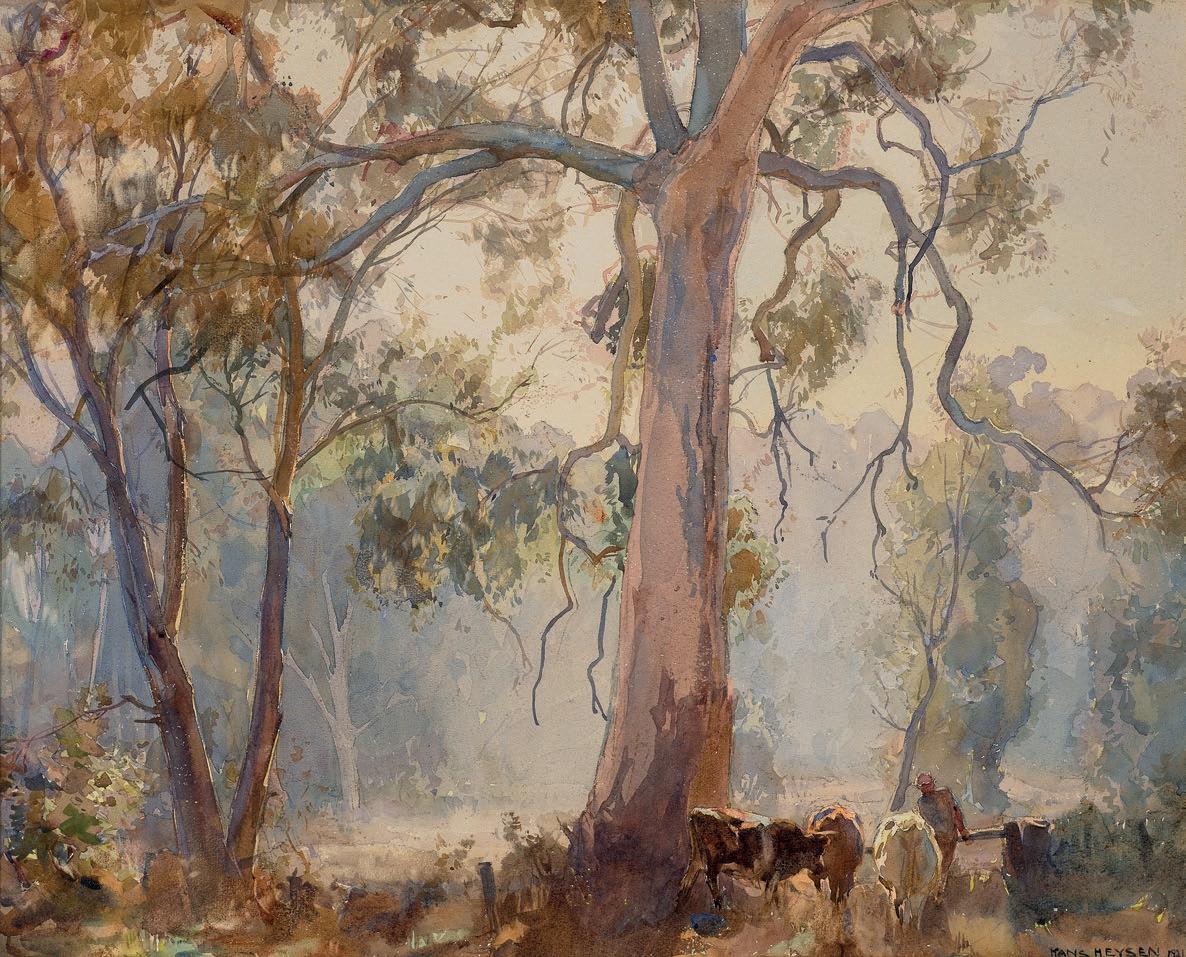
HANS HEYSEN
(1877 – 1968) ROMANCE, 1921 watercolour on paper on card 46.0 x 57.0 cm (sheet) signed and dated lower right: HANS HEYSEN 1921 inscribed verso: No. 29
ESTIMATE: $25,000 – 35,000
76
PROVENANCE
Fine Art Society’s Gallery, Melbourne Florence Colles Cox, Victoria, acquired from the above in 1921 Thence by descent Private collection, Tasmania
EXHIBITED
Retrospective Exhibition of Paintings and Drawings by Hans Heysen, Fine Art Society’s Gallery, Melbourne, 24 November – 8 December 1921 , cat. 66

HANS HEYSEN
(1877 – 1968) THE SHADOWED HILL, 1936 watercolour on paper 32.0 x 39.5 cm signed and dated lower left: HANS HEYSEN. 1936.
ESTIMATE: $15,000 – 18,000
77
PROVENANCE
S. P. & H. K. Calder, Melbourne Thence by descent S. W. Calder, Melbourne Thence by descent The Estate of Winifred B. Calder, Melbourne

SYDNEY LONG
(1871 – 1955) PINK FLAMINGOES watercolour on paper 39.5 x 66.0 cm (sight) signed lower right: SiD LONG
ESTIMATE: $15,000 – 20,000
78
PROVENANCE
Vallard House Art Gallery, Queensland Private collection, Canberra, acquired from the above in January 2002

MAX MELDRUM
(1875 – 1955) REFLECTIONS – RHODODENDRONS, 1934 oil on board 38.5 x 46.0 cm signed lower right: Meldrum
ESTIMATE: $4,000 – 6,000
79
PROVENANCE
The estate of the artist, Melbourne Thence by descent Private collection, Melbourne











